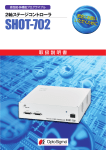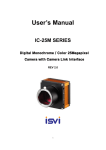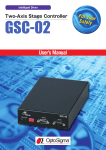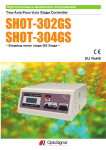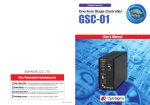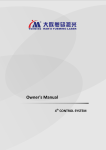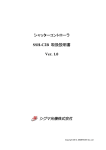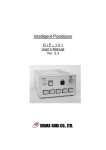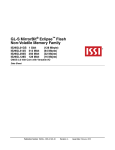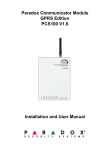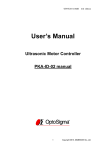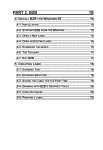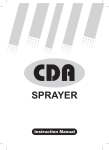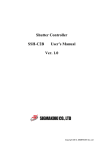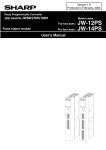Download User`s Manual Two-axis Stage Controller
Transcript
SC12201-K10-10002A User’s Manual Two-axis Stage Controller SHOT-702 1 2nd edition SC12201-K10-10002A 2nd edition Notes regarding these materials ・ These materials are intended as a reference to assist our customers in the use of the SIGMAKOKI CO., LTD. Product best suited to the customer’s application; they do not convey any license under any intellectual property rights, or any other rights, belonging to SIGMAKOKI CO., LTD. or a third party. ・ SIGMAKOKI CO., LTD. assumes no responsibility for any damage, or infringement of any third-party’s rights, originating in the use of any product data, diagram, charts, programs, or algorithms contained in these materials. ・ All information contained in these materials, including product data, diagrams, charts, programs and algorithms represents information on products at the time of publication of these materials, and are subject to change by SIGMAKOKI CO.,LTD. without notice due to product improvements or other reasons. ・ When using any or all of the information contained in these materials, including product data, diagrams, charts, programs, and algorithm, please be sure to evaluate all information and products. SIGMAKOKI CO., LTD. assumes no responsibility for any damage, liability or other loss resulting from the information contained herein. ・ SIGMAKOKI CO., LTD. products are not designed or manufactured for use in equipment or system that is used under circumstances in which human life is potentially at stake. SIGMAKOKI CO., LTD. products cannot be used for any specific purposes, such as apparatus or systems for transportation, vehicular, medical, aerospace, nuclear, or undersea repeater use. ・ The prior written approval of SIGMAKOKI CO., LTD. is necessary to reprint or reproduce in whole or in part these materials. ・ If these products or technologies are subject to the Japanese export control restrictions, they must be exported under a license Japanese government and cannot be imported into a country other than the approved destination. Any diversion or re-export contrary to the export control laws and regulations of Japan and/ or the country of destination is prohibited. 2 SC12201-K10-10002A 2nd edition Contents For Your Safety ........................................................................................................... 4 Chapter 1: Before You Begin .............................................................................. 6 1.Package Contents..................................................................................................... 6 2. Overview.................................................................................................................... 6 3. The SHOT-702 System .......................................................................................... 7 4. Parts of the SHOT-702........................................................................................... 7 Chapter 2: Basic Operations ............................................................................... 9 5.SHOT-702 Connection procedure ........................................................................ 9 6.SHOT-702 Setting.................................................................................................. 10 Chapter 3: Using SHOT-702 to position Motorized Stages ............. 17 7.Using Computer to position Motorized Stages ............................................... 17 8.Using I/O signal ...................................................................................................... 24 9. Using peripheral device to Position Motorized Stages ............................... 25 Chapter 4 : Specification ..................................................................................... 26 10. Specification ......................................................................................................... 26 11. Connector Pin Numbers and Signals ............................................................ 28 12. Exterior Dimensions .......................................................................................... 30 3 SC12201-K10-10002A 2nd edition For Your Safety Before using this product, read this manual and all warnings or cautions in the documentation provided. Only Factory Authorized Personnel should be changes and/or adjust the parts of controller. The Symbols Used in This Manual ! WARNING ! CAUTION This symbol marks warnings that should be read This symbol indicates where caution should be used and used to prevent serious injury or death. to avoid possible injury to yourself or others, or damage to property. The above indications are used together with the following symbols to indicate the exact nature of the warning or caution. Examples of Symbols Accompanying Warnings and Cautions △Symbols enclosed in a triangle indicate warnings and cautions. The exact nature of the warning or caution is indicated by the symbol inside (the symbol at left indicates risk of electrocution). ○Symbols enclosed in a circle mark indicate prohibitions(actions that must not be performed).The exact nature of the prohibition is indicates by the symbol inside or next to the circle mark (the symbol at left indicates that the product must not be disassembled). ●Symbols inside a black circle mark actions that must be performed to ensure safety. The exact nature of the action that must be performed is indicated by the symbol inside (the symbol at left is used in cases in which the AC adapter must be unplugged to ensure safety). Symbols on the product The symbol mark on the product calls your attention. Please refer to the manual, in the case that you operate the part of the symbol mark on the product. ! This symbol labeled on the portion calls your attention. 4 SC12201-K10-10002A 2nd edition Disclaimer of Liability ① SIGMAKOKI CO., LTD. does not accept liability for damages resulting from the use of this product or the inability to use this product. ② SIGMAKOKI CO., LTD. does not accept liability for damages resulting from the use of this product that deviates from that described in the manual. ③ SIGMAKOKI CO., LTD. does not accept liability for damages resulting from the use of this product in extraordinary conditions, including fire, earthquakes, and other acts of God, action by any third party, other accidents, and deliberate or accidental misuse. ④ If the equipment is used in a manner not specified by the SIGMAKOKI CO., LTD., the protection provided by the equipment may be impaired. ! WARNING ● Do not use this product in the presence of flammable gas, explosives, or corrosive substances, in areas exposed to high levels of moisture or humidity, in poorly ventilated areas, or near flammable materials. ● Do not connect or check the product while the power is on. ● Installation and connection should be performed only by a qualified technician. ● Do not bend, pull, damage, or modify the power or connecting cables. ● Do not touch the products internal parts. ● Connect the earth terminal to ground. ● Should the product overheat, or should you notice an unusual smell, heat, or unusual noises coming from the product, turn off the power immediately. ● Do not turn on the power in the event that it has received a strong physical shock as the result of a fall or other accident. ● Do not touch the stage while operation. ● Use dry clothes only for cleaning the equipment. 5 SC12201-K10-10002A 2nd edition Chapter 1: Before You Begin 1.Package Contents Purchasers of the Stage Controller should find that the package contains the items listed below. Check the package contents using the following checklist. Contact your retailer as soon as possible in the event that you should find that any item is missing or damaged. □SHOT-702 Stage Controller :1 □User’s Manual (This Manual) :1 □AC Power Cable :1 About the setting of the Memory Switch of this controller, you can set it by sample software. You can download sample programs from our web page. For the details of the samples, see the manual of each program. View our home page http://www.sigma-koki.com/ 2. Overview This controller is two axes stage controller, which has drivers for five-phase stepping motor. Because this controller has a microstep driver built-in, the smooth movement in high resolving power is possible. When the SHOT-702 is connected to an ordinary personal computer via an RS232C interface, the stage can be accurately moved to the desired position by simple commands sent from the PC. In addition, manual operation is possible facility by connecting JOYSTICK (an optional product). 6 SC12201-K10-10002A 2nd edition 3. The SHOT-702 System 4. Parts of the SHOT-702 SHOT-702 Front Panel ③ Stage driving connector ④ Stage driving connector (first axis) (second axis) ②POWER LED ①Power switch SHOT-702 Rear Panel ⑧AC connector ⑦RS232C connector ⑥connector for joy stick 7 ⑤I/O connector SC12201-K10-10002A 2nd edition Functions: ①Power switch :The product is on when the switch is set to ON. Set the switch to OFF to turn the product off. ②POWER LED : Lights up when powered. ③,④Stage driving connector :Connect to the motorized stage of your choice. Supports up to two axes. ⑤I/O connector : The connector accepts a cable for sending and receiving I/O and control signals to form an external device. It can also be used to drive motorized stages remotely or to start programmed operations. ⑥Connector for joy stick : This connector is used to connect JS-300 or JB-400 or JD-100. ⑦RS232C connector :This connector is used when the device is controlled from the computer via an RS232C interface. ⑧AC connector : This is where you connect the supplied 2.3meter power cable. ● USABLE DETACHABLE POWER CORDS Type Connecter Cord Attachment plug cap AC100-120V Use the detachable power cord set attached to the product only. AC200-240V IEC C-22 Type SJT, No16 AWG Min. NEMA6-15P Rated 7A, 250V 3-Conductors Tandem blade UL, CSA Approved (Single phased;2-current carrying & Rated 7A,250V ground) UL, CSA Approved UL, CSA Approved Cable length of above Power Supply cord shall be shorter than 4.5m. 8 SC12201-K10-10002A 2nd edition Chapter 2: Basic Operations 5.SHOT-702 Connection procedure 5-1.Connecting to Motorized Stages First, connect SHOT-702 to the motorized stages. ② Please confirm the power switch of the SHOT-702 is turning off. ② Connect a standard cable (D15RP-CA/D15D15A-CA/DMINIS-CA/DBCS-15/DMINIH-CA) to the connector of the motorized stage. ③Connect the stage to be controlled as the first axis to the STAGE1 connector of the SHOT-702 controller. Also connect the stage controlled as the second axis to the STAGE2 connector. 5-2.Connecting to PC and peripheral device Connect SHOT-702 to PC and peripherals (JS-300/JB-400/JD-100). RS232C interface is used for the connection between the PC and SHOT-702. The RS232C interface communication parameter of the SHOT-702 is described below. Please set the configurations of the PC side according to the following table. Parameter Descriptions Baud rate 38400bps Delimiters CR+LF Parity None Data bits 8bit Stop bit 1bit Flow control Hardware (RTS/CTS) or none (Default value is Hardware) ①Please confirm the power switch of the SHOT-702 is turning off. ②Use a genuine cable RS232C/STR, or 9-pin, D-SUB straight cable with male/female ends using inch screw threads. ③Insert the male connector of communications cable in to the RS232C connector on the SHOT-702. Insert the female end into the serial port on your PC. Please connect peripheral device according to the procedure from ④ to ⑥ if you use it. ④Please use a special cable MDR14-CA for the connection of peripheral device. ⑤The one side of MDR14-CA is connected with the connector of the peripheral device. ⑥The connector on the other side of MDR14-CA is connected with the JOYSTICK connector of SHOT-702. 5-3.Connecting Power Cable Connect the supplied power cable to the AC connector on the rear panel of SHOT-702 to plug the cable into an outlet. (Ensure that it is grounded.) 9 SC12201-K10-10002A 2nd edition 6.SHOT-702 Setting Adjust the drive (RUN/STOP) current and memory switch of controller for each of the connected motorized stages. 6-1.Setting the drive current Set current values supplied from SHOT-702 to stages. Turn a RUN current volume, provided on the top of the unit, to adjust RUN current corresponding to the stages to use. Use a STOP current volume to set a ratio to RUN current according to your conditions for the case where the current down function works. You can make each current adjustment for first axis or second axis independently. Note that for the STOP current, adjustment is available not for current values, but for a ratio (%) to the RUN current. Note: Generally the ratio of the STOP current to the RUN current is approx. 50%. SHOT-702 Top view Current volumes Volume (Expansion) RUN current setting (Factory-set to 0.75) Volume No. 0 1 2 3 4 5 6 Run current [A/phase] 0 0.17 0.35 0.66 0.75 0.9 1.1 STOP current settings (Factory-set to 50%) Volume No. 0 1 2 3 4 5 6 Stop current (%) 0 10 21 35 50 60 68 6-2. Setting Memory Switch SHOT-702’s various settings are set with Memory Switch. The setting change of Memory Switch is set with the sample software (SGSample/ SGCommander). Please download SGSample/SGCommander from homepage (http://www.sigma-koki.com). 10 SC12201-K10-10002A 2nd edition 6-3.Memory Switch List The memory switch has 44 setting items in all. Please set a necessary item. No Memory switch setting Range/ options Default value 1 Speed SEL 1~4 1 2 Speed 1(S) 1~500000 100 3 Speed 1(F) 1~500000 1000 4 Speed 1(R) 1~1000 200 5 Speed 2(S) 1~500000 500 6 Speed 2(F) 1~500000 5000 7 Speed 2(R) 1~1000 200 8 Speed 3(S) 1~500000 750 9 Speed 3(F) 1~500000 7500 10 Speed 3(R) 1~1000 200 11 Speed 4(S) 1~500000 1000 12 Speed 4(F) 1~500000 10000 13 Speed 4(R) 1~1000 200 14 COMM/ACK MAIN/SUB MAIN 15 Stage1 Unit PULSE/MICRO/DEG PULSE 16 Stage2 Unit PULSE/MICRO/DEG PULSE 17 Divide1 1/2/4/5/8/10/20/25/40/50/80/100/125/200/250 2 18 Divide2 1/2/4/5/8/10/20/25/40/50/80/100/125/200/250 2 19 Base Rate1 1~1000 20 20 Base Rate2 1~1000 20 21 L sensor Level1 Normal Open/Normal Close NM CLOSE 22 L sensor Level2 Normal Open/Normal Close NM CLOSE 23 O sensor Level1 Normal Open/Normal Close NM OPEN 24 O sensor Level2 Normal Open/Normal Close NM OPEN 25 N sensor Level1 Normal Open/Normal Close NM OPEN 26 N sensor Level2 Normal Open/Normal Close NM OPEN 27 Move1 POS/NEG POS 28 Move2 POS/NEG POS 29 ORG1 SEL MINI/MARK/NORM/CENTER/OFF MINI 30 ORG2 SEL MINI/MARK/NORM/CENTER/OFF MINI 31 ORG1 Speed(S) 1~500000 500 32 ORG1 Speed(F) 1~500000 5000 33 ORG1 Speed(R) 1~1000 200 11 SC12201-K10-10002A 2nd edition 34 ORG2 Speed(S) 1~500000 500 35 ORG2 Speed(F) 1~500000 5000 36 ORG2 Speed(R) 1~1000 200 37 ORG1 Pulse2 0~32000 0 38 ORG2 Pulse2 0~32000 0 39 Acceleration1 Linear/S Curve S Curve 40 Acceleration2 Linear/S Curve S Curve 41 EMG Excitation1 On/Off On 42 EMG Excitation2 On/Off On 43 OUT Level Normal High/Normal Low NM High 44 Flow Control On/Off On 6-4.Memory Switch Settings in Detail The numbers in each heading indicate the number of the memory switch setting item for the SHOT-702 1) SPEED SEL: Speed selection Choose the initial speed setting used at power on. [Options] 1 to 4 2~13) SPEED 1 to 4 (S) (F) (R): Speed settings Set the travel speed of stage (minimum S, maximum F, and acceleration/deceleration time R) [Options] S : 1 to 500000PPS F : 1 to 500000PPS R : 1 to 1000ms Note: The minimum speed (S) must be less than or equal to the maximum speed (F). 14) COM/ACK: Choose the communication protocol used when communicating with the computer. Specify whether the controller will return OK/NG in response to command signals sent from the computer in HOST (COMPUTER) mode. [Options] MAIN SUB : New system (return OK/NG when using interface) :Old system (do not return OK/NG when using interface) 15) STAGE1 UNIT: Select the units used for display (first axis) 16) STAGE2 UNIT: Select the units used for display (second axis) Choose the units used to display position coordinates of peripheral device (JS-300/JB-400). No need to set the units in case that there is no using of peripheral device (JS-300/JB-400). [Options] PULSE : Displays number of pulses MICRO : Displays number of micro [μm] DEG : Display number of degree [°] 12 SC12201-K10-10002A 2nd edition 17) Divide1: Select number of steps for 1 18) Divide2: Select number of steps for 2 [Options] 1,2,4,5,8,10,20,25,40,50,80,100,125,200,250 Number of steps = Divide = BASE RATE (in 0.1µm steps)/ (10 X travel per pulse (in µm)) 19) BASE RATE1: Travel per pulse at the base (full) step for the first axis 20) BASE RATE2: Travel per pulse at the base (full) step for the second axis Input the travel per pulse at the base (full) step for each axis. (MICRO: in 0.1-µm steps, DEG: in 0.001-degree steps) [Options] At a setting of PULSE: Disabled At a setting of MICRO: 1 to 1000 (0.1µm to 100µm) At a setting of DEG: 1 to 1000 (0.001 degrees to 1 degree) <Settings example> BASERATE = 40 for a directly motorized stage with screw lead of 2mm Stage XYZ linear stage Screw lead 0.5mm 1mm 2mm Base step angles Travel per pulse at Rotation stage 6mm 10mm - 0.72° 1μm 2μm 4μm 12μm 20μm 0.005° 10 20 40 120 200 5 base step BASE RATE 21) L sensor Level1: Specify the input logic for the first-axis limit sensor 22) L sensor Level2: Specify the input logic for the second-axis limit sensor Select the conditions (input logic) for the limit sensor for each axis. [Options] NORMAL OPEN: Normal open (switches ON from default value of OFF when limit sensor is detected) NORMAL CLOSE: Normal close (switches OFF from the default value of ON when limit sensor is detected) Motorized stages that support normal closed method: OSMS/ HPS/ HDS/ SGSP/ TSDM /TAMM/ GOHTM series. 23) O sensor Level1: Specify the input logic for the first-axis ORG sensor 24) O sensor Level2: Specify the input logic for the second-axis ORG sensor Select the conditions (input logic) for the ORG sensor for each axis. [Options] NORMAL OPEN: Normal open (switches ON from default value of OFF when limit sensor is detected) NORMAL CLOSE: Normal close (switches OFF from the default value of ON when limit sensor is detected) Motorized stages that support normal open method: OSMS/HPS/HDS/TAMM/GOHTM series. 13 SC12201-K10-10002A 2nd edition 25) N sensor Level1: Specify the input logic for the first-axis NEAR sensor 26) N sensor Level2: Specify the input logic for the second-axis NEAR sensor Select the conditions (input logic) for the NEAR sensor for each axis. [Options] NORMAL OPEN: Normal open (switches ON from default value of OFF when limit sensor is detected) NORMAL CLOSE: Normal close (switches OFF from the default value of ON when limit sensor is detected) 27) Move1: Direction of travel for first axis 28) Move2: Direction of travel for second axis Select the + direction for each axis [Options] POS: Positive (forward) rotation NEG: Negative (reverse) rotation 29) ORG1 SEL: Specify method used for return to first axis origin 30) ORG2 SEL: Specify method used for return to second axis origin [Option] MINI :MINI method MARK :MARK method NORMAL :Standard method CENTER :Median point detection method OFF :Not return origin ・MINI method CW sensor ORG SPEED(F) CW(-) CW LS detection ORG SPEED(F) CCW(+) Move 1000 pulse ORG SPEED(S) CW(-) CW LS detection ORG SPEED(F) CCW(+) Move ORG offset pulse ・MARK method ORG sensor ORG SPPED(F) NEAR sensor CW sensor CW(-) CW LS detection 1/10 ORG SPEED(S) ORG SPEED (S) CCW(+) CCW (+) N sensor detection O sensor detection 14 SC12201-K10-10002A 2nd edition ・standard method NEAR sensor ORG sensor N sensor detection ORG SPEED(S) CW(-) 1/10 ORG SPEED(S) CW(-) O sensor detection ・median point detection method CCW(CW) sensor CW(CCW) sensor ORG SPEED(F) CW(-) CW LS detection ORG SPEED (S) CCW (+) ORG SPEED(S) CW(-) ORG SPEED(F) CCW(+) ORG SPEED(S) CW(-) Move 1000 pulse CW LS detection CCW LS detection Move 1000 pulse ORG SPEED(S) CCW(+) CCW LS detection ORG SPEED(F) CW(-) Move middle of CW/CCW LS Middle of LS 31)~ ~36) ORG1/2 SPEED (S)(F)(R): Specify speed when returning to origin Set the travel speed of stage (minimum S, maximum F, and acceleration/deceleration time R) When returning to the mechanical origin for the stage on each axis. [Options] S: 1 to 500000PPS F: 1 to 500000PPS R: 1 to 1000ms Note: The minimum speed (S) must be less than or equal to the maximum speed (F). 15 SC12201-K10-10002A 2nd edition 37) ORG1 Pulse2: Set ORG offset of the first axis when MINI method set 38) ORG2 Pulse2: Set ORG offset of the second axis when MINI method set Set the travel (number of pulses) of ORG offset of each axis when MINI method set. Default value is 0. [Option] Division × 500 pulse move 0 to 32000 (unit:1=100pulse) 39) Acceleration1: Set the speed-acceleration profile of the first axis 40) Acceleration2: Set the speed-acceleration profile of the first axis [Options] Linear S Curve :trapezoidal control :S curve control 41) EMG Excitation1: Set the excitation ON/OFF of the first axis when the emergency stop 42) EMG Excitation2: Set the excitation ON/OFF of the second axis when the emergency stop [Options] ON OFF :Excitation :Free motor 43) TRG Level: Logical settings for trigger output Set the output signal level of I/O function. [Option] Normal High: When outputting signal, it becomes LOW. Normal Low: When outputting signal, it becomes HI. 44) Flow Control: Flow control selection Specify whether the controller will do flow control in RS232C communication. [Option] ON: Hardware (RTS/CTS) OFF: None 16 SC12201-K10-10002A 2nd edition Chapter 3: Using SHOT-702 to position Motorized Stages 7.Using Computer to position Motorized Stages The controller can be connected to a computer using an RS232C interface. Motorized stages can then be precisely controlled by commands (strings) transmitted from the computer. 7-1. List of Commands The following is a list of available commands: Command String Details Return to mechanical origin H: Detect mechanical origin Set number of pulses for M: Axis of movement, direction, number of relative movement Set number of pulses for pulses A: Absolute coordinates Jog command J: Move at minimum speed (S) Drive command G: Start Stop command L: Stop Set electronic (logical) origin R: Set the electronic (logical) origin to the absolute movement current position Speed settings D: Set S, F and R ORG speed setting V: Set S, F and R of ORG Free motor C: Excitation ON/OFF Switch number of steps S: Switch number of steps Status1 Q: Return current position etc. Status2 !: Return B(busy)/R(ready) Internal information ?: Check internal information Output O: Output to I/O connector Input I: Input from I/O connector 17 SC12201-K10-10002A 2nd edition 7-2. Command Format The communications protocol used between the controller and the computer depends on the memory switch COMM/ACK. 1. When COMM/ACK is set to MAIN (new system): A protocol is used in which one response is issued for each command. Command string ………… receive Response string ………… sent The response string when a command is received normally is “OK,’’ that when the command was not received, “NG.’’ In some cases, for example in response to confirmation commands, data will be returned instead of “OK.’’ Commands should only be sent after checking the internal status of the controller. 2. When COMM/ACK is set to SUB (old system): A protocol is used in which the controller does not respond to each command. Data will however be returned in response to some commands, such as confirmation commands. To determine whether or not a command was received normally, use the Q command to check status. 7-3.Commamd in Detail (1) H command: Return to mechanical origin Features: This command is used to detect the mechanical origin for a stage and set that position as the origin. Once the mechanical origin has been detected, the value displayed will be 0. The stage will move at the speed specified in the ORG1 (2) SPEED (S, F, R) memory switches. H: 1 Detect the mechanical origin for the first axis. H: 2 Detect the mechanical origin for the second axis. H: W Detect the mechanical origin for the first and second axes. (2) M command: Set number of pulses for relative travel Features: This command is to specify the axis of travel, direction, and the travel (number of pulses). This command must always be followed by a drive (G) command. Travel is by means of acceleration/deceleration driving. The distance traveled is specified in pulses. M: 1+P1000 Travel 1000 pulses in the + direction on the first axis G: M: 2- P 10000 Travel 10000 pulses in the - direction on the second axis G: M: W+P500-P200 Travel 500 pulses in the + direction on the first axis and 200 pulses in the G: direction on the second axis 18 SC12201-K10-10002A 2nd edition (3) A command: Set number of pulses for absolute travel Features: This command is to specify the axis of travel, direction, and the travel (number of pulses). This command must always be followed by a drive (G) command. Travel is by means of acceleration/deceleration driving. The distance traveled is specified in the number of pulses depending on the control method. This command also returns the axis to the electrical (logical) origin. A: 1-P2000 Travel to the 2000 pulse position in the - direction on the first axis. G: A: 2+P30000 Travel to the 30000 pulse position in the + direction on the second axis. G: A: W+P1000-P2000 G: Travel to the 1000 pulse position in the + direction on the first axis and the 2000 pulse position in the - direction on the second axis (4) J command: JOG Features: This command drives stages continuously (at a constant speed) at the starting speed (S). This command must always be followed by a drive (G) command. J:1+ move in the + direction on the first axis. G: J:2- move in the - direction on the second axis. G: J:W-+ move in the - direction on the first axis and in the + direction on the second axis G: (5) G command: Drive Features: When a drive command is issued, the stage starts moving, moves the specified number of pulses, and then stops. The G command is used after M, A, and J commands. G: Drive G Drive (6) L command: Decelerate and stop Features: When this command is executed, the stage decelerates and stops. L:1 First axis decelerates and stops L:2 Second axis decelerates and stops L:W First- and second-axis decelerate and stop 19 SC12201-K10-10002A 2nd edition (7) L: E command: Emergency stop Features: This command stops all stages immediately, whatever the conditions. L:E Stop first and second axes immediately (8) R command: Set electronic (logical) origin Features: This command is used to set electronic (logical) origin to the current position of each axis. R:1 Set the electronic (logical) origin for the first axis R:2 Set the electronic (logical) origin for the second axis R:W Set the electronic (logical) origins for the first- and second-axis (9) D command: Speed settings Features: The minimum speed (S), maximum speed (F), and acceleration/deceleration time (R) are set according to the SPEED SEL memory switches when the power is turned on. This command allows you to change these initial settings. The following options are available: Minimum speed(S) 1~500000PPS Maximum speed (F) 1~500000PPS Acceleration/deceleration time (R) 1~1000mS Note that the minimum speed (S) must be less than or equal to the maximum speed (F). D:1S100F1000R50 Adjust speed settings for the first axis (S=100PPS/F=1000PPS/ R=50ms) D:2S1000F5000R200 Adjust speed settings for the second axis (S=1000PPS/F=5000PPS/ R=200ms) D:WS100F1000R200S100F1000R200 First-axis speed settings Adjust speed settings for the first- and second-axis Second-axis speed settings 20 SC12201-K10-10002A 2nd edition (10) V command: ORG speed settings Features: ORG speed (minimum speed (S), maximum speed (F), and acceleration/deceleration time (R)) is set according to the SPEED SEL memory switches when the power is turned on. This command allows you to change these initial settings. The following options are available: Minimum speed(S) 1~500000PPS Maximum speed (F) 1~500000PPS Acceleration/deceleration time (R) 1~1000mS Note that the minimum speed (S) must be less than or equal to the maximum speed (F). V:1S100F1000R50 Adjust ORG speed settings for the first axis (S=100PPS/F=1000PPS/ R=50ms) V:2S1000F5000R200 Adjust ORG speed settings for the second axis (S=1000PPS/F=5000PPS /R=200ms) V:WS100F1000R200S100F1000R200 First-axis speed settings Adjust speed settings for the first- and second-axis Second-axis speed settings (11) C command: Free/ hold motor (Excitation ON/OFF) Features: This command is used to excite the motor or to turn excitation off, making it possible to move (rotate) stages manually. The options available are 0: free motor, and 1: excitation (hold motor). C:10 Free first-axis motor C:21 Excite (hold) second-axis motor C:W1 Excite (hold) both the first- and second-axis motors (12) S command: Changing the number of steps Features: Use this command to change motor step angle (number of steps). Select one of the following 15 step angles built into the driver. First specify an axis, then set the value. S: 180 Divides the step angle of the first axis into 80 angles. S: 280 Divides the step angle of the second axis into 80 angles. If the base step (full step) angle is to 0.72 degrees, the stepping motor makes one full turn every 500 pulses. The motor is said to have a minimum resolution of 0.72 degrees (if the motor moves 10 mm for each turn, minimum resolution=10 mm ÷ 500 pulses=20μm). You can change the minimum resolution by dividing the motor step angle (1/2=0.36°). 21 SC12201-K10-10002A Number of 2nd edition 1 2 4 5 8 10 20 25 40 50 80 Step angle 0.72° 0.36° 0.18° 0.144° 0.09° 0.072° 0.036° 0.0288° 0.018° 0.0144° 0.009° Number of 500 1000 2000 2500 4000 5000 10000 12500 20000 25000 40000 100 125 200 250 Step angle 0.0072° 0.00576° 0.0036° 0.00288° Number of 50000 62500 100000 125000 steps pulses per full turn Number of steps pulses per full turn (13) Q command: Status 1 Features: On receipt of this command, the controller returns the coordinates for each axis and the current state of each stage. Q: - 100,- 200,ACK1,ACK2,ACK3 …… Data returned First-axis Second-axis Three-character coordinates coordinates string data ACK1 ・・・・・・・・・ X:Command or parameter errors. K :Command received normally. ACK2 ・・・・・・・・・ L :First axis stopped at LS M:Second axis stopped at LS W:First and second axes stopped at LS K :Normal stop ACK3 ・・・・・・・・・ B:(BUSY) L, Q ,and ! commands can be received R:(READY) all commands can be received ※Coordinate values for each axis have a fixed length of ten digits, including symbols (Symbols are left-aligned, coordinates values right-aligned). 22 SC12201-K10-10002A 2nd edition (14) ! command: Status 2 Features: On receipt of this command, the controller returns the stage operating status. !: ACK3 ・・・・・・・・・ Data returned ACK3 ・・・・・・・・・ B:(BUSY) L, Q, ! , and P commands can be received R:(READY) all commands can be received (15) ? command: Request for internal information Features: This command returns controller settings. ?: [Parameter] [AXIS] Parameter Data returned Examples V Version numbers V1.00 P Travel per pulse 1.00,1.00 S Division 2,2 D Travel speed S100F1000R200 B ORG speed S500F5000R200 (16) O command: Output Features: This command changes the output status. [Option] O:0 Set the output signal to Normal level (Default value: High) O:1 Output signal (Default value: Signal will be Low level when outputting signal ) (17) I command: input Features: This command checks the input status. Signal level is active low. [Option] I: 0 or 1 …Data returned 0: negative 1: active 23 SC12201-K10-10002A 2nd edition 8.Using I/O signal SHOT-702 has following I/O signal functions. Output-1 point Emergency stop input-1 point Busy signal output-1 point Input-1 point (photo-coupler input) ①Output This is output port. Output signal can be controlled by O command. Output logic is switchable by memory switch. Default value is normal HI. ②Busy signal output Outputting signal when motorized stages moving. Busy signal level is switchable by memory switch. Default value is normal HI. ③Input This is input port. Input signal can be checked by I command. Input logic is active low. ④EMG STOP input EMG STOP is photo-coupler input (8-2). EMG STOP turns on when the current passes in TLP281 by EMG STOP terminal being connected to ground. PC or peripheral device can't move Motorized stages when EMG STOP signal turns on. If EMG STOP signal turn off, motorized stages can move again. However, controller is necessary to turn on the power supply again because it enters the state that cannot be operated due to the communication fault when there are communication statements from PC while EMG STOP turns on. 8-1 OUT/BUSY_OUT circuit 8-2 IN/EMG_STOP circuit 24 SC12201-K10-10002A 2nd edition 9. Using peripheral device to Position Motorized Stages The controller can be connected to a peripheral device (JS-300/JB-400/JD-100). Motorized stages can then be manual controlled and displayed the position coordinates for each axis by peripheral device. For the details, see the User’s manual of peripheral device (JS-300/JB-400/JD-100). 25 SC12201-K10-10002A 2nd edition Chapter 4 : Specification 10. Specification 1) General specifications Power source AC 100-240V Consumption 70VA Operating temperature 5 to 40℃ Storage temperature -20 to 60℃ Altitude up to 2000m 50/60Hz Indoor use only Installation category Ⅱ Pollution degree 2 Ambient humidity 20 to 80%RH (no condensation) External dimensions 260W x280D x70H (excluding projections) Weight 2.8 kg (2) Performance Controlling axis 2 axis Maximum driving speed (F) 1 to 500kPPS Minimum driving speed (S) 1 to 500kPPS Acceleration/deceleration time (R) Sensor input 1 to 1000ms Origin sensor/proximity sensor/CW (-) limit/CCW (+) limit (Memory switches can be used to change input logic for sensors.) Method of return to origin MINI method/MARK method/Standard method Median point detection method/Not return origin (You can change method of ORG by Memory Switch) Interface RS232C interface Communication Parameters - Baud rate 38400 - Data bits 8 bits - Parity None - Stop bit 1 bit - Flow control Hardware - Delimiters CR+LF 26 SC12201-K10-10002A I/O 2nd edition 1 input point (photo-coupler input, internal resistance 390Ω) 1 output point (Open-collector output, maximum use conditions DC24V 50mA) Control signals Emergency stop-1 point (photo-coupler input, internal resistance 390Ω) BUSY 1 point (Open-collector output, maximum use conditions DC24V 50mA) (3) Driver Specifications Driver type Bi-polar pentagon micro-steps system Driving electric current (output current) 0.1A/phase to 1.1A/phase Current down (stop current) 0.1A/phase to 0.7A/phase Division (micro-step) settings 1, 2, 4, 5, 8, 10, 20, 25, 40, 50, 80, 100, 125, 200, 250 divisions (4) Electrical fast transmit/burst immunity EN61000-4-4 (2004) Level2 (5) Electrical isolation voltage When AC1kV 60Hz is applied between the power terminal and the case for one minute at room temperature and humidity, no abnormality shall occur. (6) Surge immunity EN61000-4-5 (2006) Level2 (7) Electrostatic discharge EN61000-4-2 (1995)+A1 (1998)+A2 (2001) Level2. 27 SC12201-K10-10002A 11. Connector Pin Numbers and Signals 11-1.I/O Connector Signals No. Name No. Name 1 OUT 5 - 2 Busy 6 GND 3 IN 7 +5V 4 EMG STOP 8 - HR212-10RA-8SDL (72) (HIROSE products) used 11-2. STAGE1,2 Connector No. Name No. Name 1 Blue: motor wiring 9 - 2 Red: motor wiring 10 - 3 Orange: motor wiring 11 LS (+): limit detection on + 4 Green: motor wiring 12 LS (-): limit detection on- 5 Black: motor wiring 13 GND: common sensor 6 GND: common sensor 14 NEAR: proximity detection 7 ORG: mechanical origin 15 +24V: sensor power supply detection 8 +24V: sensor power supply Female XM2F-1510 connector (OMRON products) used 11-3. RS232C Connector No. Name No. Name 1 - 6 DTR 2 TxD 7 CTS 3 RxD 8 RTS 4 DSR 9 - 5 SG XM3B-0922-132 connector (OMRON products) used 28 2nd edition SC12201-K10-10002A 11-4. JOYSTICK Connector No. Name No. Name 1 GND 9 +5V 2 +5V 10 RXD- 3 RXD+ 11 TXD- 4 TXD+ 12 CONNECT 5 STOP 13 - 6 - 14 - 7 - 8 GND 10214-52A2PL (Sumitomo 3M products) used 29 2nd edition SC12201-K10-10002A 12. Exterior Dimensions 30 2nd edition SC12201-K10-10002A 2nd edition SIGMAKOKI CO., LTD. Tokyo Head Office SIGMAKOKI Tokyo Head office 19-9, Midori 1 chome, Sumida-ku, Tokyo 130-0021, JAPAN Tel:+81-3-5638-8228 Fax:+81-3-5638-6550 e-mail: [email protected] Technology center 1-1 Yatsukaho, Hakusan-shi, Ishikawa, 924-0838, Japan 31































